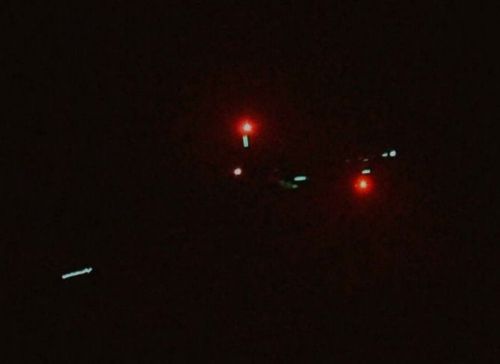US Air Force forcibly carries out another nighttime parachute drop training off coast of Tsukenjima, ignoring local people’s objections

Multiple objects were dropped from an MC-130 special operations plane (right) at 8:33 p.m. on August 9, off the coast of Tsukenjima Island, Uruma City (Photograph taken by Futoshi Hanashiro)
August 10 2017 Ryukyu Shimpo
The U.S. Air Force began to conduct a night time parachute drop training within the sea of the Tsukenjima Training Area, Uruma City, at around 8 p.m. on August 9.
The Okinawa Prefectural Government and Uruma City Office urged the U.S. military to cancel the training in the area.
However, the U.S. military forcibly carried out the training ignoring the local governments’ request.
It was the fifth time the parachute drop training has been held in the area.
The training had previously been carried out during daylight hours, but this was the first time it was held at night.
Uruma City Mayor Toshio Shimabukuro told a Ryukyu Shimpo reporter, “I will continue to ask for cancellation of the training in the Tsukenjima Training Area.”
There are fishing grounds for mozuku seaweed near the training area, and sometimes fishing boats use the area.
Regular ships between the Main Island and Tsukenjima Island also sail near the training area.
“The training could be a hindrance to the economic activities of citizens… if there is a crash, potential oil leakage could create a very serious situation,” local residents said.
The prefecture and city officials have repeatedly made strong requests to stop the parachute drop training at the Tsukenjima Training Area when they were notified by the U.S. military.
However, the U.S. military officials have insisted that the training was held within “an approved training area.” The parachute drop training is being continuously carried out at the Tsukenjima Training Area.
At around 8:20 p.m., an aircraft, which is speculated to be an MC-130 special operations plane that took off from the U.S. Kadena Air Base, appeared above the Tsukenjima Training Area.
It was confirmed that at least eight objects were dropped from the aircraft several times in the dark.
The training lasted until around 10 p.m.
The prefectural government has asked the U.S. military to use the Iejima Auxiliary Airfield for the parachute drop training, because it is allowed to conduct such training according to the final report of the SACO agreement.
Meanwhile, the central government allows the U. S. military’s use of the Tsukenjima Training Area for the parachute drop training.
Both sides have a different view on the use of the Tsukenjima Training Area for parachute drop training.
(English translation by T&CT)
Previous Article:Governor Onaga says Osprey accident like the crash off Australia’s coast was “bound to happen”
Next Article:MCAS Futenma’s Ospreys have an 8.3% crash rate, 10 total incidents since deployment
[Similar Articles]
- Local fishermen oppose U.S. parachute drop training by Tsukenjima during mozuku peak season
- US military conducts parachute drop training ignoring local objections
- US military ignores local residents’ objections to parachute drop training in Uruma
- MC-130J aircraft observed at low altitude after sixth U.S. military parachute drop training of 2021
- Parachute drop training forcibly conducted at night
 Webcam(Kokusai Street)
Webcam(Kokusai Street)


